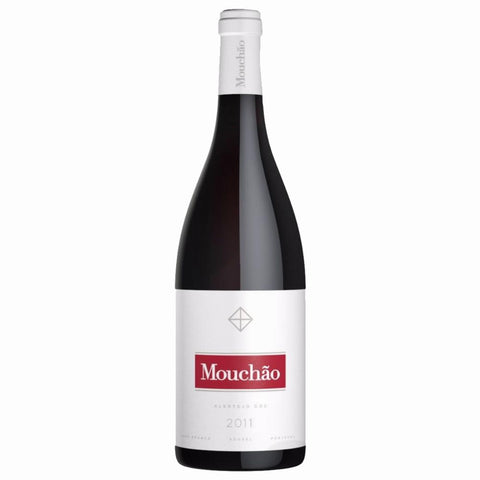
67Wine
Herdade do Mouchao Red Alicante Bouschet 2013 750ml
Wine Advocate 93 Points | The 2013 Tinto, the regular estate bottling, is a 76/24 blend of Alicante Bouschet and Trincadeira. It was aged for 36 months in used 5,000-liter tonels of varying ages and comes in at 14% alcohol. Still elegant, this has fleshed out a bit and certainly doesn't seem thin. It does many other things brilliantly, though. Alternating silk and velvet for texture, it is simply sensual, and caressing on the palate. The nuanced finish with waves of beefy Alicante adds complexity. This is also a little restrained—the tannins are moderate, but they certainly increase with air. You can drink this now, but it should still improve and will steadily get better. This is lovely. I'm not convinced it is a truly great one yet, at least in the context of this winery's history.
Decanter 95 Points | From this large region’s most historic estate, 70% of the blend is Alicante Bouschet, showing exotically spicy black fruit aromas leading to structure and depth on the palate, great individuality, and freshness and acidity for the long term. Excellent. Drinking Window 2018 - 2030.
Wine & Spirits Magazine 94 Points | The Reynolds family released their first bottling from their Mouchão estate in 1949, and it soon became a legendary wine in Portugal. The family had come to the Alentejo in the 1800s, as part of the cork trade, and settled on a ranch northeast of Estremoz, eventually planting vines in the 1870s when some professors from Montpellier traveled to the region with cuttings of a recent cross, alicante bouschet. This blend is a selection of the top parcels of alicante bouschet, and includes about 15 percent trincadeira, the grapes fermented in stone lagars, the wine aged in old wooden vats for three years, then another two in bottle prior to release. It starts out as a narrow, tense wine with a cool, spicy bite to the finish. Then it keeps developing over the course of hours and days, the wine’s alcohol completely incorporated into floral blueberry flavors, its youth showing in bright notes of bee pollen, more August than September or October. As it gains some fat and turns silken, the wine shows what it will become with another five to ten years in bottle.
The Estate’s flagship wine was first bottled in 1949. Sourced predominantly from the Estate’s best Alicante Bouschet grapes from the Carapetos, Ponte das Canas and Dourada vineyards, with up 15% of other local varieties – mainly Trincadeira – grown on the Estate. The latter provides an important aromatic component as Alicante Bouschet’s primary aromas are naturally shy.
Wine Information:
Country: Portugal
Region: Alentejo
Sub-Region:
Appellation: Alentejo
Variety: Alicante Bouschet
Type: Reds
Size: 750ml
-
Wine Advocate 93 points The 2013 Tinto, the regular estate bottling, is a 76/24 blend of Alicante Bouschet and Trincadeira. It was aged for 36 months in used 5,000-liter tonels of varying ages and comes in at 14% alcohol. Still elegant, this has fleshed out a bit and certainly doesn't seem thin. It does many other things brilliantly, though. Alternating silk and velvet for texture, it is simply sensual, and caressing on the palate. The nuanced finish with waves of beefy Alicante adds complexity. This is also a little restrained—the tannins are moderate, but they certainly increase with air. You can drink this now, but it should still improve and will steadily get better. This is lovely. I'm not convinced it is a truly great one yet, at least in the context of this winery's history.Decanter 95 points From this large region’s most historic estate, 70% of the blend is Alicante Bouschet, showing exotically spicy black fruit aromas leading to structure and depth on the palate, great individuality, and freshness and acidity for the long term. Excellent. Drinking Window 2018 - 2030.Wine & Spirits Magazine 94 points The Reynolds family released their first bottling from their Mouchão estate in 1949, and it soon became a legendary wine in Portugal. The family had come to the Alentejo in the 1800s, as part of the cork trade, and settled on a ranch northeast of Estremoz, eventually planting vines in the 1870s when some professors from Montpellier traveled to the region with cuttings of a recent cross, alicante bouschet. This blend is a selection of the top parcels of alicante bouschet, and includes about 15 percent trincadeira, the grapes fermented in stone lagars, the wine aged in old wooden vats for three years, then another two in bottle prior to release. It starts out as a narrow, tense wine with a cool, spicy bite to the finish. Then it keeps developing over the course of hours and days, the wine’s alcohol completely incorporated into floral blueberry flavors, its youth showing in bright notes of bee pollen, more August than September or October. As it gains some fat and turns silken, the wine shows what it will become with another five to ten years in bottle.

